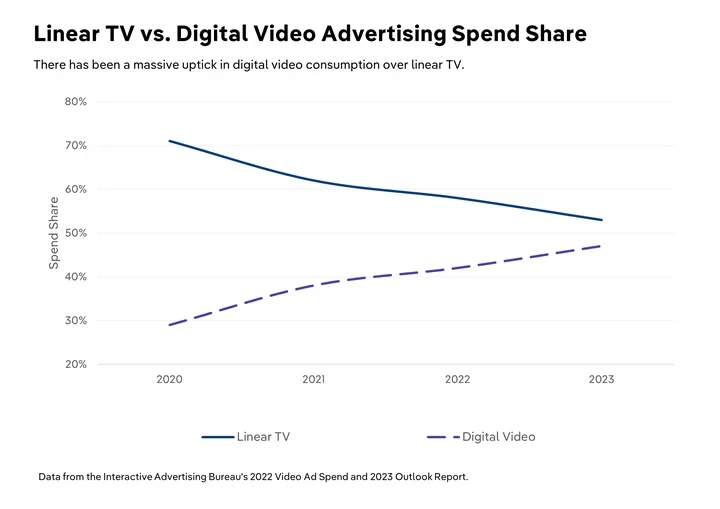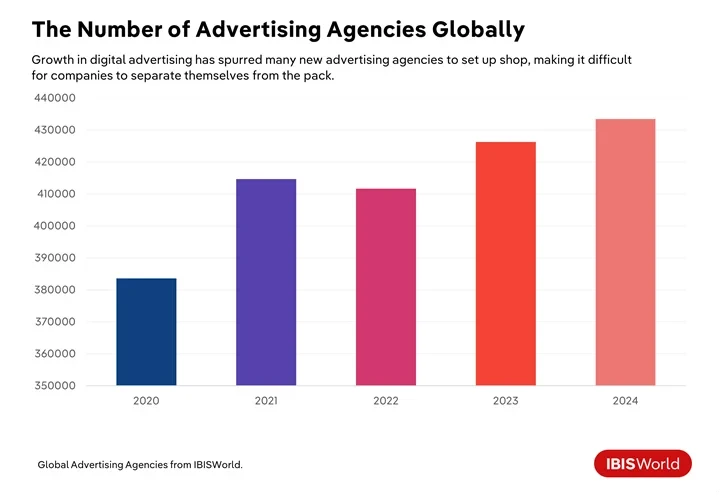Key Takeaways
Authentic influencer marketing and brand storytelling appeal to skeptical consumers, boosting trust with personalized ads that align with their values.
Higher mobile usage and cord-cutting have driven digital video advertising growth. Implementing AI, AR and VR can be crucial in creating engaging ad campaigns.
Changes in consumer behavior have resulted in a shift to programmatic advertising, making data-driven and automated ad buying more efficient.
The advertising world has transformed dramatically, due to evolving consumer behavior and the introduction of groundbreaking new technology. Mastering the art of navigating these complex changes is essential for crafting effective marketing strategies. Employing innovative approaches such as AI-driven personalization, influencer marketing, augmented reality (AR), virtual reality (VR), and voice search optimization is imperative to address challenges like ad fatigue and standing out in the crowded digital advertising landscape. For brands and advertising agencies, adopting these burgeoning trends and maintaining a connection with consumers in a constantly changing market is crucial for establishing a strong market presence.
The Current State of Digital Advertising
Digital advertising has shifted massively towards digital video and away from television advertising. A significant uptick in “cord-cutting” – canceling traditional cable in favor of streaming and digital TV options — and the massive growth of connected TV (CTV) streaming platforms has contributed to this shift.

While many consumers can easily bypass advertisements on various streaming platforms like Netflix, Max and Hulu, the high costs of having various premium plans have driven some consumers to lower subscription tiers. Netflix launched its ad-supported tier in 2022 and gained five million subscribers in six months. Netflix recently stated in October of 2023 that 30.0% of new subscribers selected the add-supported tier in regions where available.
The rise of social media advertising on platforms like TikTok, Facebook and Instagram have also contributed to shifting advertising toward digital video. Advertisers have increasingly used short advertising videos for consumers on mobile devices as they spend more time on their phones, contributing to 65.5% of digital advertising expenditure going to mobile ad spending.
With these changes, digital advertising has become increasingly saturated. Ad fatigue has contributed to an uptick in consumers using ad-blockers and considerable declines in click-through rates. The rise of digital advertising has also led to substantial growth in the number of advertising agencies, contributing to the saturation of the market.

Furthermore, advertising tactics have evolved towards programmatic ad buying to enhance click-through rates. This approach automates the purchasing and selling of ads, leveraging data analytics to increase ad effectiveness significantly. By 2024, programmatic ad buying is projected to represent 91.3% of digital display advertising in the US. Mobile advertising predominantly utilizes programmatic ad buying, making up 70.6% of digital display’s programmatic purchases in 2023. Although there’s a decline in programmatic ad buying for digital displays on laptops and desktops, its use has surged in connected TV (CTV) platforms as businesses pivot to this emerging format.
How Emerging Technologies Shape Strategies
Emerging technologies play a pivotal role in enhancing consumer targeting for advertisements and elevating ad campaign engagement levels. The integration of AI, AR, VR, and voice search technologies significantly impacts consumer interactions with brands. This impact drives advertisement engagement and fosters deeper brand loyalty through personalized, immersive experiences.
AI-driven personalization stands at the forefront, significantly increasing the success of advertising campaigns by making ads timely and highly relevant. Leveraging consumer data, AI personalization tailors advertisements to match individual preferences, exemplified by Spotify’s Discover Weekly playlist. This AI-curated playlist, tailored to users’ listening histories, serves as a powerful tool in the highly competitive music streaming industry.
Further enhancing the consumer experience, Augmented reality (AR) transforms the shopping experience by allowing consumers to virtually try on clothes or visualize furniture in their homes, enhancing the purchasing process for items like apparel, footwear, furniture, and makeup. IKEA’s Place App is an example of this, letting users photograph their space and virtually place furniture with precise dimensions, even simulating the effect of different lighting and shadows on how furniture looks. This AR application significantly bolsters e-commerce sales by increasing consumer confidence in how new items will fit into their spaces.
Moreover, virtual reality (VR) offers consumers immersive experiences in various settings. An early innovator, Marriott’s Teleporter VR Experience, provided virtual travel experiences to destinations like Hawaii or London. Participants could step into “teleporters” for a 100-second sensory journey, complete with air pumps, scent dispensers and mist, to mimic the actual experience.
Lastly, voice search optimization streamlines the way consumers locate products and services, enhancing user experience across platforms. Starbucks’ implementation of voice-activated ordering through Alexa, Google Assistant, and iOS exemplifies this, simplifying the ordering process. This convenience, appealing to both existing and potential customers, may amplify brand loyalty and encourage a shift in consumer preferences.
Key Success Factors
- Investment in AI and Machine Learning: Advertising professionals should prioritize the integration of AI and machine learning into their campaigns. By automating data analysis, these technologies can identify trends and patterns in consumer behavior, enabling the creation of highly personalized and targeted ads. This approach enhances the relevance of advertisements to individual consumers and improves ROI by focusing resources on high-opportunity segments.
- Leverage AR and VR for Immersive Experiences: To stand out in a crowded market, advertisers should explore the potential of augmented reality (AR) and virtual reality (VR) to create immersive and engaging ad experiences. This could include AR filters on social media platforms for trying on products or VR tours that introduce consumers to a service or destination. Providing these unique experiences can significantly boost engagement and conversion rates.
- Optimizing for Voice Search: With the growing use of digital assistants like Alexa and Siri, optimizing content for voice search is becoming increasingly important. Advertising professionals should include natural language keywords and FAQs in their content strategy to improve visibility in voice search results. This ensures that brands remain accessible to consumers using this rapidly expanding search method.
- Continuously Monitor and Adapt to Platform Changes: The digital landscape is constantly evolving, with social media platforms regularly updating algorithms and introducing new features. Advertising professionals must stay informed about these changes and be willing to adapt their strategies accordingly. This might involve shifting ad budgets to emerging platforms where their target audience is increasingly active or experimenting with new ad formats that have become more effective due to algorithm updates.
Adapting to Evolving Consumer Behavior
Consumers increasingly crave personalized experiences and brands that reflect their values. This shift has led to growing skepticism towards traditional advertisements. In response, companies have begun revising their marketing approaches to win consumer approval.

Influencer marketing has emerged as an effective strategy in this new landscape, offering a more personal touch for consumers who trust and follow these influencers. Ads shared by influencers often feel more authentic and tend to earn greater trust from the audience. Furthermore, user-generated content, such as testimonials shared on social media and other platforms, adds an extra layer of authenticity and credibility to products.
Today’s consumers are more socially and environmentally conscious than ever before, gravitating towards brands that showcase a clear purpose beyond their products. Brands that engage in authentic storytelling and foster community engagement can create a loyal following that transcends the immediate value of their products.
An exemplary case of leveraging authentic storytelling and community engagement is the TOMS One for One initiative, which donates a pair of shoes for every pair sold. The TOMS Virtual Giving Trip, a virtual reality experience, allows consumers to see firsthand the positive impact of the brand’s mission, enhancing the authenticity and appeal of TOMS’ commitment. This initiative has attracted loyal customers and inspired other businesses to adopt similar social initiatives.
In conclusion, brands must stay abreast of rapid changes in consumer behavior, allowing these shifts to guide their marketing strategies. By leveraging technology, embracing personalized experiences, and showcasing a clear sense of purpose, brands can connect with consumers on a deeper level, cultivating brand loyalty and driving sales. With the right approach and tools, businesses can stay ahead in the ever-evolving consumer landscape.
Key Success Factors
- Engage in Authentic Storytelling: Advertising professionals should focus on crafting authentic stories that resonate with their target audience’s values and experiences. This involves moving beyond just selling a product or service to narrating a brand’s purpose, its impact on the community, or how it addresses consumer needs in a genuine way. Authentic storytelling can significantly enhance brand loyalty and consumer trust, especially among younger audiences who value transparency and social responsibility.
- Utilize Data-Driven Personalization: Implement advanced analytics and customer segmentation to deliver personalized advertising experiences. By harnessing data from multiple touchpoints, advertisers can create highly targeted campaigns that speak directly to consumers’ individual needs and preferences. Personalization can range from customized email marketing messages to individualized online shopping experiences, ensuring that each consumer feels uniquely recognized and valued.
- Foster Community and Co-Creation: Develop platforms for consumers to engage with the brand and each other. This could involve creating online forums, social media groups, or co-creation platforms where consumers can contribute ideas for new products or improvements. Such strategies empower consumers, giving them a voice and a stake in the brand’s evolution, which can foster a stronger community and deepen brand engagement.
Final thoughts
Embracing a forward-thinking mindset and leveraging technological advancements are key strategies for thriving in the fast-paced world of advertising. Modern consumers seek personalized experiences and brands that align with their values, prompting agencies to find ways to develop impactful campaigns. Advertising agencies ready to adjust to new technologies and shifts in consumer behavior are set for expansion. In this dynamic environment, agility becomes an advantage and a requirement. Brands that embrace this evolution are positioned to excel.
Source from IBISWorld
Disclaimer: The information set forth above is provided by ibisworld.com independently of Alibaba.com. Alibaba.com makes no representation and warranties as to the quality and reliability of the seller and products.




